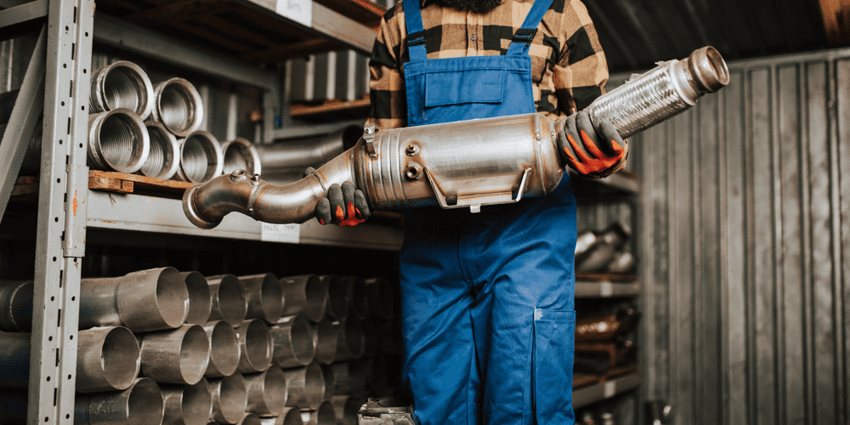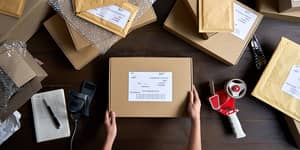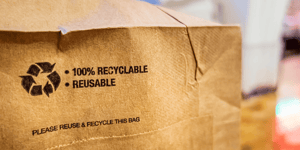Items that fit into a standard box are pretty easy to prepare for shipping. First, you place the item into a double wall corrugated cardboard box and fill any excess space with appropriate padding to fill the void. Always use high quality materials for your shipments. Consider strength, cushioning and durability when selecting your packaging supplies Finally, you label the shipment with our barcoded label, and it is ready for transport.
At times, you may be required to package large and odd-shaped items in a single unit. These items are more challenging to ship. Items of this nature include, musical instruments and car parts. These require special attention to keep the shipping overhead at a minimum and to protect the goods from transit damages.
We've put together a list of techniques to incorporate, so that the carrier can handle your package better.
Use an external shipping box for secondary packaging
When shipping oddly shaped items, you might be tempted to use an extra-large box for external packaging that leaves a lot of additional space around the items. This could actually backfire, leaving the peanuts or bubble wrap to move during transit, but also leaving you with more shipping and handling costs. Ideally, your box should have two inches of extra space on all sides. A great way to think about secondary packaging and its importance is not only to think about its primary use to protect the product, but also as a form of retail display.
Use protective fillers and wraps
Make sure your item is cushioned properly. Empty space can lead to damage to the package during transit. Use wadded packing paper or foam as a thick layer of padding on the bottom of a shipping box, foam peanuts and at least 5 cm of bubble wrap packaged around the item to prevent it shifting and to fill the container completely.. You can use any of the following materials to fill the void in your box:
- Bubble wrap: The ultimate option in wrapping protection, the air-filled bubbles cushion and insulate warped objects.
- Air cushions: Air cushions have become extremely popular in the last few years. They are exceptionally light and economical. Air is pumped in between layers of film to create a cushion - of different sizes - that can be used to fill a lot of space.
- Foam cushioning: Foam provides more cushioning than paper. It is waterproof and comes in a range of thicknesses. The thicker the foam the more cushioning it will provide.
- Packing peanuts: Lightweight and economical, packing peanuts have been the chosen void fill in the packaging industry for decades. You must make sure that you use enough material to completely fill the extra space in the box to minimise shifting.
Use pallets for heavy, large items
If your product is too heavy or too large then your item will need to be packaged securely onto a pallet. Pallets are platforms made of wood or plastic that are used to combine items for shipping into one packaged container. This facilitates easier transportation. They are deliberately packaged tightly with shrink wrap to avoid being damaged during transportation.
- Arrange boxes and cartons by size to maximise space
- Make sure the pallet is large enough to prevent overhang of shipment pieces.
- Make sure to leave no air space between boxes
- Pad the outside corners and edges with cardboard
- Shrink wrap the pallet as tight as possible
Insure your package
Play it safe and insure your packages. All signature service parcels sent through Interparcel automatically come with $100 transit cover, and the option to add up to $2,000. This applies to all signature services unless you are sending a Restricted Item. Restricted items are deemed a little fragile to send via the courier network, so are only covered for loss. More information can be found under "Prohibited and Restricted Items" on our website here. Make sure that you take photos of the item before wrapping to document its original condition.
Common odd shapes, and how to pack them?
Pointed products
You can use the following techniques for packing pointed items such as chandeliers and other home decor items:
- Dismantle the pointed product as much as possible. Make sure to wrap every single piece twice, with bubble wrap. If you have multiple pieces, pack them into different boxes.
- Find a cardboard box a bit larger than your product, and add padding on all sides of the cardboard box. (padding must be internally, external padding to the outside of a cardboard box won't protect the item internally).
- Place the product in the cardboard box, and fill the void with paper or packing peanuts, so that it's tightly stuffed.
- Add a layer of thick foam on the top of the package and seal the cardboard box with packing tape so that it's secure to move.
Long products
Products like golf clubs, poles, car bumpers and garden tools typically need additional support on the weaker sections and proper packaging so that your shipment does not interrupt the conveyor when in transit. Use the following tips to ensure that you don't incur a manual handling fee:
- Wrap the entire length of the item in bubble wrap or thin foam.
- Depending on the product, if you find a particular section to be weaker than another, wrap that section in multiple layers of bubble wrap.
- Place the item in a long cardboard box, making sure that the void space is filled with packing peanuts and the box is sealed appropriately.
- Do not use any cylindrical boxes to pack your material as this can disrupt the conveyor belt and incur a manual handling fee.
Circular products
For packing items like wheels, footballs, globes, helmets or other circular objects, you can use the following steps:
- Wrap the item completely with bubble wrap or polyethylene foam
- Place it in a cardboard box. Make sure it's large enough so the sides are not bulging out
- Fill the extra space with craft paper or other fillers so that the object is not moving inside the box
Picture frames, artwork and collectibles
Framed pictures have glass - glass that can shatter into a thousand pieces if not packaged with care. Protect the financial value of your frames by packaging it step by step:
- Measure the length, width and thickness of the frame, adding six inches to each dimension. Use these dimensions when choosing a box.
- Wrap the picture frame in at least two layers of packing foam or bubble wrap, just like you're wrapping a present. You can use small bubble packaging so that it doesn't leave any indentations on the artwork or glass.
- Wrap the frame with another layer. This time with bigger bubble wrap or thicker foam
- Secure the box with sealing tape and package in a double wall corrugated box.
Get in touch!
If you're still not sure how to prepare your package, why not Contact Us? We'd love to hear from you and we're always happy to help!










 Facebook
Facebook Twitter
Twitter Instagram
Instagram Linked In
Linked In YouTube
YouTube